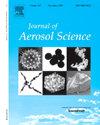Characterization of highly conducting ionic liquid (EMI-BF4)mEMIn+ nanoclusters injected into dielectrics to produce compound electrosprays
IF 3.9
3区 环境科学与生态学
Q2 ENGINEERING, CHEMICAL
引用次数: 0
Abstract
Electrospraying of dielectric liquids presents unique challenges compared to conducting liquids, as it requires external charge injection. This manuscript further explores the Charge Injection Atomization (CIA) technique, which employs two concentric capillaries to create a compound electrospray. The inner liquid is an ionic liquid (IL), which injects nanodrops and perhaps also ions into the dielectric. The evaporation of the dielectric liberates these charged particles into the gas phase, where they are analyzed with a Differential Mobility Analyzer (DMA). The mobility spectra show very narrow peaks of high mobility (corresponding to ions) and broader, lower mobility peaks representing IL nanodrops. In this work, the effects of both the ionic liquid and dielectric flow rates on droplet diameter and charge are thoroughly studied. Through a simple assumption that the mobility of the droplets agrees with Stokes-Millikan and the condition that the droplets are spherical of known density, the diameter and mass over charge, are determined, revealing average values ranging from 7 to 90 kDa and diameters from 3 to 35 nm. The charge density of the droplets seems to suggest that they are charged to a fraction between 50 and 100% of the Rayleigh limit and are affected mostly by the ionic liquid flow rate as expected. Given the broad interest of IL, the controlled size production of nanoclusters in dielectrics can have important implications in synthesis and catalysis, polymer chemistry, electrochemistry, microemulsions and biotechnology.

求助全文
约1分钟内获得全文
求助全文
来源期刊

Journal of Aerosol Science
环境科学-工程:化工
CiteScore
8.80
自引率
8.90%
发文量
127
审稿时长
35 days
期刊介绍:
Founded in 1970, the Journal of Aerosol Science considers itself the prime vehicle for the publication of original work as well as reviews related to fundamental and applied aerosol research, as well as aerosol instrumentation. Its content is directed at scientists working in engineering disciplines, as well as physics, chemistry, and environmental sciences.
The editors welcome submissions of papers describing recent experimental, numerical, and theoretical research related to the following topics:
1. Fundamental Aerosol Science.
2. Applied Aerosol Science.
3. Instrumentation & Measurement Methods.
 求助内容:
求助内容: 应助结果提醒方式:
应助结果提醒方式:


